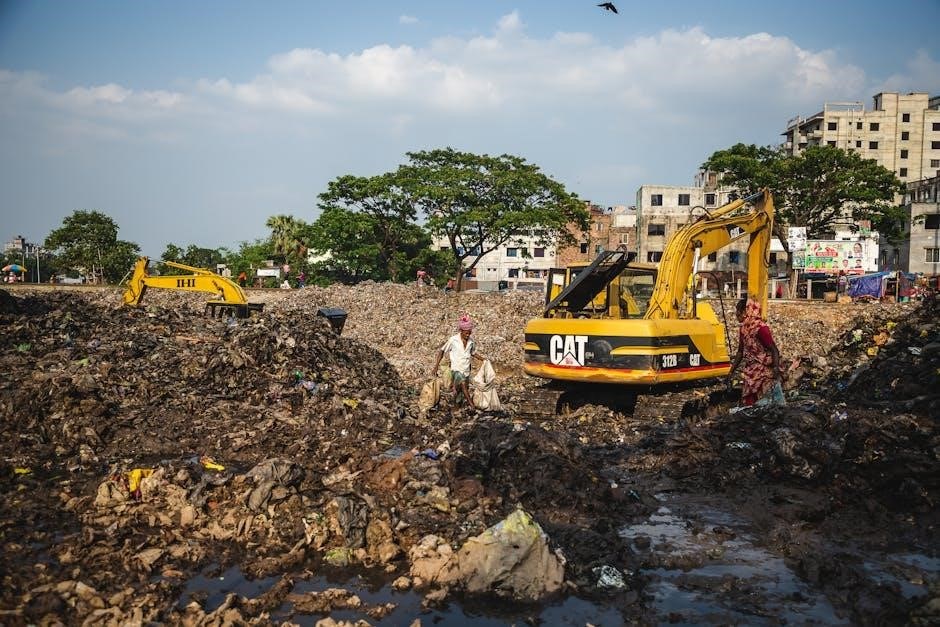A garbage compactor manual is a comprehensive guide detailing the operation‚ installation‚ and maintenance of waste compactors. It ensures efficiency and safety‚ offering step-by-step instructions for residential and commercial use. This manual serves as a vital reference for operators and technicians‚ outlining key features and functions for optimal performance.
What is a Garbage Compactor?
A garbage compactor is a machine designed to reduce the volume of waste by compressing it into a more compact form. These devices are commonly used in both residential and commercial settings to manage waste efficiently. Compactors work by applying significant force to the waste material‚ typically through a hydraulic or electric mechanism‚ to minimize its size and prevent waste overflow.
They are available in various types‚ including manual‚ electric‚ and hydraulic models‚ each suited for different applications. Garbage compactors are particularly useful in urban areas where space is limited and waste management is a priority. By reducing waste volume‚ they help lower disposal costs and environmental impact.
Modern compactors often feature advanced safety mechanisms and user-friendly controls. They are widely used in households‚ restaurants‚ and industrial facilities to handle bulky or hazardous waste. Regular maintenance and proper operation‚ as outlined in the manual‚ are essential to ensure optimal performance and longevity of the equipment.
Common issues with garbage compactors include hydraulic system failures‚ malfunctioning compacting mechanisms‚ and electrical system problems. Proper troubleshooting and repair‚ as detailed in the manual‚ can help resolve these issues efficiently.
Overall‚ a garbage compactor is a valuable tool for effective waste management‚ offering both practical and environmental benefits when used correctly.
Importance of a Manual
A garbage compactor manual is an essential resource for ensuring the safe and efficient operation of the equipment. It provides detailed instructions for installation‚ maintenance‚ and troubleshooting‚ helping users avoid potential hazards and optimize performance.
The manual serves as a comprehensive guide‚ outlining proper usage‚ safety precautions‚ and technical specifications. It equips users with the knowledge to handle common issues‚ such as hydraulic system failures or electrical malfunctions‚ without requiring external assistance.
By following the manual‚ operators can extend the lifespan of the compactor and prevent costly repairs. It also ensures compliance with safety standards and regulations‚ reducing the risk of accidents.
For technicians‚ the manual offers diagnostic tools and repair procedures‚ enabling them to resolve problems efficiently. It acts as a reference for training new users‚ ensuring consistent and proper operation.
Brief History of Garbage Compactors
The concept of garbage compactors dates back to the mid-20th century‚ emerging as a solution to urban waste management challenges. Early models were rudimentary‚ focusing on reducing waste volume through basic compression. Over time‚ advancements in hydraulic systems and automation transformed compactors into efficient tools for both residential and industrial use.
In the 1960s‚ the first hydraulic compactors were introduced‚ enabling greater force and compaction power. These systems quickly gained popularity in commercial settings‚ such as restaurants and retail stores‚ where waste management was a daily concern. The development of electric compactors further expanded their accessibility‚ making them suitable for home use.
Modern garbage compactors are highly sophisticated‚ featuring advanced safety mechanisms‚ dual control systems‚ and specialized designs for different waste types. They are now integral to waste recycling and disposal processes worldwide‚ supported by detailed manuals that guide users in optimal operation and maintenance.
Throughout their evolution‚ garbage compactors have played a crucial role in improving waste management efficiency‚ reducing environmental impact‚ and promoting sustainability. Their continued innovation ensures they remain a vital tool in addressing global waste challenges.

Key Components of a Garbage Compactor
A garbage compactor consists of a hydraulic system‚ compacting mechanism‚ and safety features. The hydraulic system powers the compactor‚ while the mechanism compresses waste. Safety features ensure safe operation‚ protecting users from potential hazards during the compaction process.
Hydraulic System
The hydraulic system in a garbage compactor is a critical component that powers the compaction process. It consists of pumps‚ motors‚ and cylinders‚ which work together to generate the force needed to compress waste. The system operates by converting electrical energy into hydraulic pressure‚ which is then transferred to the compacting mechanism. Proper maintenance of the hydraulic system is essential to ensure efficient operation‚ as leaks or worn-out components can lead to reduced performance. Regular checks should be performed to ensure fluid levels are adequate and that all connections are secure. In case of a failure‚ it is important to refer to the manual for troubleshooting steps or to contact a professional technician. A well-maintained hydraulic system ensures the compactor functions optimally‚ reducing waste volume effectively.
Compacting Mechanism
The compacting mechanism is the heart of a garbage compactor‚ responsible for compressing waste into a smaller volume. It typically consists of a ram or roller system that applies force to the waste material‚ pushing it into a compacted form. This mechanism is driven by either hydraulic or electric power‚ depending on the model. The compacting process is usually cyclic‚ with the ram moving forward to compress the waste and then retracting to allow more waste to be added.
Key components of the compacting mechanism include the compactor ram‚ rollers‚ and bearings. The ram is the moving part that directly compresses the waste‚ while the rollers and bearings ensure smooth operation and reduce friction. Proper lubrication of these components is essential to maintain efficiency and prevent wear. Regular maintenance‚ such as inspecting for worn-out parts and ensuring alignment‚ is crucial to extend the lifespan of the mechanism.
If the compacting mechanism malfunctions‚ it may result in incomplete compression or jamming. Common issues include misaligned rollers‚ damaged bearings‚ or blockages in the compactor chamber. Troubleshooting steps often involve clearing obstructions‚ lubricating moving parts‚ and replacing worn components as needed. A well-functioning compacting mechanism ensures effective waste reduction and optimal performance of the compactor.
Safety Features
Safety features in a garbage compactor are essential to prevent accidents and ensure safe operation. These mechanisms are designed to protect users from potential hazards associated with the machine’s powerful compacting forces. Key safety features include emergency stop buttons‚ safety sensors‚ and interlocks that prevent the compactor from operating when the door is open or when a jam is detected.
Modern compactors often include automatic shut-off systems that halt operation if an obstruction or overload is detected. Some models also feature protective guards to prevent hands or objects from entering the compacting area. Additionally‚ sensors can detect irregular movements or excessive pressure‚ triggering an immediate stop to avoid damage or injury.
According to manuals and troubleshooting guides‚ regular inspection of safety mechanisms is crucial. Users are advised to ensure all safety devices are functioning properly before operating the compactor. Failure to follow safety guidelines can lead to malfunctions or accidents‚ emphasizing the importance of adhering to the manufacturer’s instructions.
These safety features not only enhance user protection but also contribute to the overall efficiency and longevity of the garbage compactor. By prioritizing safety‚ operators can minimize risks and maintain a smooth waste management process.

Installation and Setup
Proper installation and setup of a garbage compactor are crucial for efficient operation. Ensure the site is prepared‚ and follow the manual’s guidelines for leveling and securing the machine. Post-installation testing confirms functionality and safety‚ ensuring optimal performance from the start.
Pre-Installation Checks

Before installing a garbage compactor‚ several critical checks must be performed to ensure a smooth and safe setup process. First‚ verify that the installation site meets all spatial and structural requirements‚ as outlined in the manual. Check for level ground and adequate clearance around the machine to facilitate proper operation and maintenance.
- Ensure the power supply matches the compactor’s specifications to avoid electrical issues.
- Inspect the hydraulic and electrical components for any damage or leaks.
- Confirm that all safety features‚ such as emergency stop buttons and sensors‚ are functional.
- Review local regulations and ensure compliance with environmental and safety standards.
- Prepare the necessary tools and accessories recommended by the manufacturer.
These pre-installation checks are essential for ensuring the compactor operates efficiently and safely. Failure to address any issues may lead to malfunctions or hazards during operation.
Step-by-Step Installation Guide
Installing a garbage compactor requires careful adherence to the manufacturer’s instructions to ensure proper functionality and safety. Begin by preparing the site‚ ensuring it is level and clear of debris. Next‚ unpack the compactor and all accompanying components‚ verifying that no parts are damaged or missing.
- Position the compactor in the designated area‚ aligning it with the floor anchors provided.
- Secure the unit to the floor using the anchors to prevent movement during operation.
- Connect the hydraulic and electrical systems according to the manual’s specifications‚ ensuring all hoses and wires are tightly secured.
- Install any additional features‚ such as safety sensors or remote controls‚ as outlined in the guide.
- Test the compactor’s basic functions‚ including the compaction cycle and safety mechanisms‚ before putting it into full operation.
Following these steps ensures a safe and efficient installation process. Always refer to the manual for specific instructions tailored to your compactor model.
Post-Installation Testing
After installing the garbage compactor‚ thorough testing is essential to ensure optimal performance and safety. Begin by powering on the unit and checking the control panel for any error messages or illuminated indicators.
- Verify the power supply is stable and the compactor is properly connected to the electrical system.
- Inspect all hydraulic lines and connections for leaks or damage.
- Run a test compaction cycle to ensure the mechanism operates smoothly and reaches full compression.
- Check the safety features‚ such as emergency stop buttons and sensors‚ to confirm they function correctly.
- Test the compactor’s ability to handle different types and quantities of waste as specified in the manual.
- Ensure all moving parts‚ such as rollers and doors‚ operate without obstruction or noise.
- Review the test results and address any issues before permitting regular use.
This step ensures the compactor is ready for safe and efficient operation‚ minimizing the risk of future malfunctions.
Operating the Garbage Compactor
Operating a garbage compactor involves ensuring safe and efficient waste management. Always follow the manual’s guidelines‚ monitor the compaction process‚ and maintain proper hygiene. Regular checks help prevent malfunctions and ensure longevity of the equipment.
Normal Operation
Normal operation of a garbage compactor involves loading waste into the unit‚ ensuring the drawer or compartment is closed securely‚ and activating the compaction cycle. Always follow the manual’s instructions for proper loading to avoid overfilling or jamming. Use the control panel to start the compactor‚ and allow it to complete the cycle fully.
Ensure all safety features‚ such as emergency stops and sensors‚ are functioning correctly before each use. Regularly inspect the compactor for wear and tear‚ and address any issues promptly to maintain efficiency. Proper operation ensures safe‚ effective waste management and extends the lifespan of the equipment.
Refer to the manual for specific guidelines on loading materials‚ cycle times‚ and noise levels. Always keep the area around the compactor clean and clear of obstacles to prevent accidents. By adhering to normal operating procedures‚ you can maximize the compactor’s performance and minimize downtime.
Special Operating Modes
Garbage compactors often feature special operating modes designed for specific scenarios‚ enhancing efficiency and versatility. One common mode is the manual override‚ allowing operators to control the compactor’s functions directly for maintenance or troubleshooting. Another mode is the timed cycle‚ where the machine operates at set intervals to compact waste continuously‚ ideal for high-traffic environments.
Some advanced models include a quiet operation mode‚ reducing noise levels for use in residential areas or during off-hours. Additionally‚ certain compactors offer an adaptive compaction mode‚ adjusting pressure based on waste density to optimize results. These modes ensure the compactor adapts to varying needs‚ improving performance and reducing wear on the machine.
Always refer to the manual to understand and activate these special modes correctly. Improper use may lead to inefficient operation or equipment damage. By leveraging these features‚ users can tailor the compactor’s performance to specific requirements‚ ensuring effective waste management in diverse settings.
Emergency Stop Procedures
In case of an emergency‚ garbage compactors are equipped with specific stop mechanisms to ensure safety and prevent damage. The first step is to locate the emergency stop button‚ typically found on the control panel or near the operating area. Pressing this button will immediately halt all operations‚ including hydraulic and compaction functions.
Once the machine is stopped‚ ensure all personnel are clear of the compactor. Do not attempt to resume operation until the issue causing the emergency has been resolved. If the compactor is part of a larger system‚ such as a truck-mounted unit‚ follow the manufacturer’s guidelines for safe shutdown procedures.
After activating the emergency stop‚ inspect the machine for any obstructions or malfunctions. Consult the manual for diagnostic steps or error codes that may indicate the cause of the issue. If the problem persists‚ contact a certified technician to avoid further complications.
Remember‚ emergency stop procedures are critical for preventing accidents and ensuring the longevity of the equipment. Always prioritize safety and follow the manual’s instructions precisely when dealing with unexpected situations.

Safety Precautions and Best Practices
Always wear protective gear and ensure proper training before operating. Use safety features like emergency stops and follow manual guidelines. Keep children away and avoid overloading. Regular maintenance prevents malfunctions and ensures safe operation. Prioritize caution to avoid accidents and extend equipment lifespan.
General Safety Guidelines

Personal Protective Equipment (PPE): Always wear appropriate PPE‚ such as gloves‚ safety glasses‚ and steel-toe boots‚ when operating or maintaining the compactor to prevent injuries from sharp objects or moving parts.
Proper Training: Ensure all operators are fully trained and understand the compactor’s functions‚ safety features‚ and emergency procedures. Never allow untrained individuals to operate the machine.

Usage Limits: Use the compactor only for its intended purpose‚ as specified in the manual. Avoid overloading or compacting prohibited materials‚ such as hazardous waste or flammable substances.
Regular Maintenance: Schedule routine inspections and maintenance to identify and address potential issues before they escalate. Lubricate moving parts and replace worn components promptly.
Emergency Preparedness: Keep emergency stops easily accessible and test them regularly. Ensure fire extinguishers and first aid kits are nearby. Post emergency contact information for quick response.
Environmental Awareness: Follow local regulations for waste disposal and compacting. Ensure the compactor is installed in a well-ventilated area to prevent hazardous fumes buildup.
Child Safety: Keep children away from the compactor at all times‚ as the machine can cause severe injury if misused or accessed improperly.
By adhering to these guidelines‚ you can minimize risks‚ ensure safe operation‚ and extend the lifespan of your garbage compactor.
Operational Safety Tips
- Ensure the Compactor Area is Clear: Always check the surrounding area for obstacles or personnel before starting the compactor to prevent accidents.
- Use the Foot Pedal Safely: Operate the compactor using the foot pedal as designed‚ avoiding manual force that could lead to unintended movement.
- Avoid Overloading: Do not exceed the recommended capacity‚ as overloading can cause mechanical stress and malfunction.
- Monitor for Jams: Stop the machine immediately if unusual noises or vibrations occur‚ indicating potential jams or misalignment.
- Check Power Supply: Ensure the compactor is properly plugged in and the circuit breaker is functioning. Avoid using damaged cords or outlets.
- Ensure Proper Alignment: Verify that the compactor’s drawer is fully closed and aligned before operation to prevent operational issues.
- Lubricate Moving Parts: Regularly lubricate hinges‚ rollers‚ and hydraulic components to maintain smooth operation and prevent wear.
- Keep the Area Clean: Regularly clean the compactor and surrounding space to avoid accumulation of flammable or hazardous materials.
- Avoid Prohibited Materials: Do not compact items like batteries‚ aerosols‚ or liquids‚ as they can pose fire or environmental risks.
- Test Emergency Stops: Periodically test the emergency stop feature to ensure it functions correctly in case of an emergency.
- Proper Shutdown: Always follow the manual’s shutdown procedure to avoid sudden stops that could damage the machine or cause injury.
By following these operational safety tips‚ you can ensure a smooth‚ incident-free experience while using your garbage compactor.
Emergency Procedures
In case of an emergency‚ follow these steps to ensure safety and minimize damage:
- Activate the Emergency Stop: Immediately press the emergency stop button or pull the emergency stop cord to halt the compactor’s operation.
- Disconnect Power: Switch off the power supply at the circuit breaker or unplug the compactor from the electrical outlet to prevent further movement.
- Evacuate the Area: Clear the surrounding area of personnel and ensure no one approaches the machine until it is deemed safe.
- Check for Trapped Waste: If the compactor jams or seizes‚ do not attempt to manually remove waste. Contact a professional technician to avoid injury or further damage.
- Inspect Hydraulic Systems: In case of hydraulic failure‚ check for fluid leaks or component damage. Do not restart the machine until repairs are completed.
- Report the Incident: Document the incident and notify your supervisor or maintenance team to schedule a thorough inspection and repair.
- Follow Restart Procedures: After resolving the issue‚ refer to the manual for proper restart procedures to ensure safe and efficient operation.
By adhering to these emergency procedures‚ you can safeguard personnel‚ prevent equipment damage‚ and maintain a safe working environment. Always prioritize caution and professional assistance when dealing with critical situations.
Troubleshooting Common Issues
Identify and resolve issues like hydraulic system failures‚ jammed compacting mechanisms‚ or electrical malfunctions. Refer to the manual for diagnostic steps‚ repair guidance‚ and maintenance tips to restore optimal performance and ensure safe operation of the garbage compactor.
Hydraulic System Failure
A hydraulic system failure is a common issue in garbage compactors‚ often caused by fluid leaks‚ pump malfunctions‚ or blocked valves. Symptoms may include reduced compaction force‚ slow operation‚ or complete system shutdown. To diagnose‚ check fluid levels and inspect for visible leaks. Faulty hydraulic pumps or cylinders may require replacement‚ while clogged valves can be cleaned or serviced. Always refer to the manual for specific repair procedures and ensure proper safety measures‚ such as disconnecting power before performing maintenance. Regular lubrication and fluid checks can prevent such failures. Addressing hydraulic issues promptly is crucial to maintain efficiency and avoid further damage to the compactor. Proper repair and maintenance ensure reliable operation and extend the lifespan of the hydraulic system.

Malfunctioning Compacting Mechanism

A malfunctioning compacting mechanism is a frequent issue in garbage compactors‚ often resulting from worn-out bearings‚ misaligned rollers‚ or obstructions in the compaction chamber. Symptoms may include uneven compaction‚ loud noises‚ or the mechanism failing to cycle properly. To address this‚ inspect the chamber for debris or large objects that may block movement. Lubricate moving parts to reduce friction and ensure proper alignment of rollers and bearings. If components are damaged‚ replace them promptly to prevent further damage. Regular maintenance‚ such as cleaning and lubrication‚ can help prevent malfunctions. Always refer to the manual for specific repair procedures and safety guidelines. Addressing issues early ensures efficient operation and extends the lifespan of the compactor. Proper care of the compacting mechanism is essential for reliable performance and waste management efficiency.
Electrical System Issues

Electrical system issues are a common cause of garbage compactor malfunctions. These problems often manifest as the compactor failing to start‚ intermittent operation‚ or complete system shutdown. Causes may include faulty wiring‚ tripped circuit breakers‚ or damaged electrical components. If the compactor does not turn on‚ check the power supply and ensure the outlet is functioning properly. Verify that the circuit breaker has not tripped and that all connections are secure. Inspect the wiring for signs of damage‚ such as frayed cords or exposed wires‚ and replace any compromised components. Additionally‚ ensure the compactor is properly grounded to prevent electrical hazards. If the issue persists‚ consult a licensed electrician to diagnose and repair complex electrical faults. Regularly inspecting the electrical system and addressing minor issues promptly can prevent major breakdowns. Always refer to the manual for specific troubleshooting steps and safety precautions to avoid further damage or safety risks. Proper maintenance of the electrical system is crucial for reliable operation and longevity of the compactor.